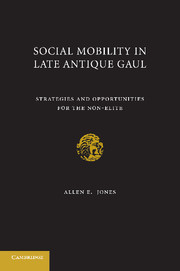Book contents
- Frontmatter
- Contents
- ACKNOWLEDGMENTS
- ABBREVIATIONS
- Gaul in the Late Sixth Century
- CHAPTER ONE INTRODUCTION: BARBARIAN GAUL
- CHAPTER TWO EVIDENCE AND CONTROL
- CHAPTER THREE SOCIAL STRUCTURE I: HIERARCHY, MOBILITY, AND ARISTOCRACIES
- CHAPTER FOUR SOCIAL STRUCTURE II: FREE AND SERVILE RANKS
- CHAPTER FIVE THE PASSIVE POOR: PRISONERS
- CHAPTER SIX THE ACTIVE POOR: PAUPERES AT CHURCH
- CHAPTER SEVEN HEALING AND AUTHORITY I: PHYSICIANS
- CHAPTER EIGHT HEALING AND AUTHORITY II: ENCHANTERS
- CHAPTER NINE CONCLUSION
- BIBLIOGRAPHY
- INDEX
CHAPTER ONE - INTRODUCTION: BARBARIAN GAUL
Published online by Cambridge University Press: 18 December 2009
- Frontmatter
- Contents
- ACKNOWLEDGMENTS
- ABBREVIATIONS
- Gaul in the Late Sixth Century
- CHAPTER ONE INTRODUCTION: BARBARIAN GAUL
- CHAPTER TWO EVIDENCE AND CONTROL
- CHAPTER THREE SOCIAL STRUCTURE I: HIERARCHY, MOBILITY, AND ARISTOCRACIES
- CHAPTER FOUR SOCIAL STRUCTURE II: FREE AND SERVILE RANKS
- CHAPTER FIVE THE PASSIVE POOR: PRISONERS
- CHAPTER SIX THE ACTIVE POOR: PAUPERES AT CHURCH
- CHAPTER SEVEN HEALING AND AUTHORITY I: PHYSICIANS
- CHAPTER EIGHT HEALING AND AUTHORITY II: ENCHANTERS
- CHAPTER NINE CONCLUSION
- BIBLIOGRAPHY
- INDEX
Summary
The historian is generally occupied far more with great events and imposing characters than with the quiet, dim life which flows on in silent, monotonous toil beneath the glare and tumult of great tragedies and triumphs. It is natural that it should be so.
SAMUEL DILL, Roman Society in Gaul in the Merovingian AgeLate Antiquity, stretching roughly from the late third through seventh centuries, was an age characterized by transition. In that period, Europe experienced dramatic political and social changes: Western imperial rule disappeared, replaced by smaller kingdoms, trade and taxation declined, aristocrats concentrated on more proximate interests, and Roman and indigenous cultures merged. Furthermore, Christian thought and practice increasingly infiltrated and influenced European politics, society, and culture. Inhabitants of Gaul were in theforefront in experiencing these important societal shifts. Gallic society forever changed with the introduction of peoples whom the sources label “barbarians.” Sizeable migrating groups passed through and/or settled in Gaul from the first decade of the fifth century. According to the chronicle tradition, bands of Vandals, Sueves, and Alans moved westward over the Rhine River from December 406. By 409, some had proceeded to Spain and North Africa, while others stayed. The Empire responded to these movements by expanding a policy of settling the “barbarians” as foederati, federate soldiers. In 413, the Western government settled Burgundians along the upper Rhine, and in 418 it placed Visigothic foederati in the province of Aquitania Secunda. By then, Franks had long been serving a similar purpose in northern Gaul.
- Type
- Chapter
- Information
- Social Mobility in Late Antique GaulStrategies and Opportunities for the Non-Elite, pp. 1 - 22Publisher: Cambridge University PressPrint publication year: 2009



